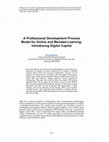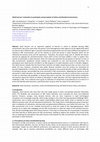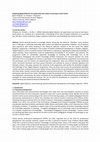Papers by Brent Philipsen

Since information and communication technologies were introduced into education, the number of co... more Since information and communication technologies were introduced into education, the number of courses delivered in an online or blended learning (OBL) format has increased significantly. However, not all teachers are experienced in teaching in this new digital environment. While various teacher professional development (TPD) models exist, few target OBL and teachers' change processes during professional development. Therefore, this article presents a five-phase TPD process model for OBL. The five phases of the model are (a) a need for TPD for OBL, (b) the professional development strategy, (c) the teacher change associated with OBL, (d) the recognition and appreciation of these changes, and (e) the anchoring of the changes made in the teachers' everyday practice. The model presented can offer a valuable and new approach toward TPD for OBL and introduces the notion of digital capital into TPD for OBL.

TECHNOLOGY, PEDAGOGY AND EDUCATION, 2019
This article aims to shed light on our understanding of how teacher reflection could be fostered ... more This article aims to shed light on our understanding of how teacher reflection could be fostered through online teacher professional devel- opment. In this respect, the presented article starts from three theoretical foundations, namely the characterisation of online teacher professional development, logic modelling and fostering teacher reflection. Based on these foundations, a logic model is constructed and subsequently used to analyse an online teacher professional development programme. The examined online teacher professional development trajectory is the Digital Didactics programme, which originated in Flanders (Dutch-speak- ing part of Belgium). Twenty participants and four coaches participated in the study. The results explain how reflection was fostered through several online teacher professional development programme features. The reflective practices that formed the main outcomes of this study were mainly from a behavioural, attitudinal and social nature. The con- clusions drawn can inform both theory and practice on how online teacher professional development could instigate teacher reflection.

The increased number of courses taught in an online environment has led to more teachers in need ... more The increased number of courses taught in an online environment has led to more teachers in need of professional development for online or blended teaching. Although various professional development programs have been scrutinised, only a few studies integrate the feelings of teachers during their professional development process. Teachers' feelings form an inherent part of their teacher-selves and are reflected in their everyday practice. Therefore, this study uses a hermeneutic phenomenological research method to examine the lived experiences – the feelings – of educational staff within a professional development program that targets online and blended teaching. The results indicate that teachers experience a large range of feelings and that these fluctuate throughout the program. These include positive feelings of connectivity, responsibility, and satisfaction, but also more negative feelings of chaos and frustration. The recognition and understanding of these feelings can illuminate particular aspects of professional development that are experienced more positively or negatively, which can guide further efforts for qualitative improvement.

In order to fully realise the potential of online and blended learning (OBL), teacher professiona... more In order to fully realise the potential of online and blended learning (OBL), teacher professional development (TPD) strategies on how to teach in an online or blended learning environment are needed. While many studies examine the effects of TPD strategies, fewer studies target the specific important components of these strategies. This study addresses that gap by conducting a systematic review of qualitative data consisting of 15 articles on TPD that targets OBL. Using a meta-aggregative approach, six different synthesised findings were identified and integrated into a visual framework of the key components of TPD for OBL. These synthesised findings are the base for the action recommendations which present specific and contextualised suggestions. Taken together, the findings can inform in-service teachers and trainers, together with further research and development efforts that are concerned with TPD for OBL.

The Internet and Higher Education
Online and blended learning (OBL) is intended for individualising education. However, while OBL a... more Online and blended learning (OBL) is intended for individualising education. However, while OBL attracts a diverse range of students, teachers lack insight into this diversity, which hinders them in anticipating students' individual needs. The present mixed methods' study examines the reasons and values that students in a teacher training programme in higher education attribute to their participation in OBL. Firstly, three motivational profiles were distinguished. Furthermore, the students value the flexibility and the face-to-face moments in OBL. However, based upon students' current experiences, costs - seen as negative aspects of OBL - seem to emerge. While students mainly mention costs regarding education in general (e.g. a high workload), they also indicate specific costs concerning OBL (e.g. harder to organise group work). A cost-value balance affects students' decisions to persist. Therefore, this study provides the values and costs that teachers should bear in mind for each profile.

Adult learners are an important segment of learners in online or blended learning (OBL) environme... more Adult learners are an important segment of learners in online or blended learning (OBL) environments. But at the same time, this group is very heterogeneous with regard to (1) the digital skills which are diverse due to different ages or previous educational opportunities and can lead to different perceptions of working in OBL environments, and (2) the motives to enroll and persist in adult education which can be influenced by previous work and life experiences. Therefore, the present study aims to identify the learner diversity by applying the self-determination theory (SDT) of Deci and Ryan (2000) in order to explore their motives to participate in adult education. Next, this study also examined the perceptions of learners to learn in OBL environments. Qualitative content analysis was conducted on nine semi-structured interviews. The participants were adult learners enrolled in an OBL program in an adult education center in Flanders, Belgium. The adult learners indicate that the face-to-face moments are highly valued because they can learn more and better this way. However, sometimes they prefer distance moments since the content can sometimes be learned independently. Furthermore, the participants agreed on the practical benefits of OBL and the difficulty of working in groups, and provided tips to be successful in OBL environments. Regarding the motives to enroll and persist in adult education, the adult learners generally participate to be able to continue their current job, to have an alternative job possibility, or because they want a new job. The current study informs institutions and teachers about the motives of adults to participate in adult education and their experienced benefits or challenges in OBL. This is relevant since it gives an indication of components to be attentive to or to work on in online and blended adult education, specifically when trying to meet the needs of the adult learners.

Online teaching became increasingly popular during the last decennia. Therefore, many teachers fa... more Online teaching became increasingly popular during the last decennia. Therefore, many teachers face a challenge in combining technology with content and didactical approaches. However, not all teachers have experience with online teaching or the didactical approach towards it. For this reason the 'Digital Didactics' programme is developed in the context of teacher professional development in Flanders, Belgium. 'Digital Didactics' strives to provide teachers with hands-on experiences regarding the didactical possibilities of online teaching. These experiences could be implemented immediately in the teachers' own practice. The programme builds on scientifically supported knowledge on teaching with technology such as the Technological, Pedagogical and Content Knowledge (TPACK) framework. The research question this study addresses is first to investigate the reasons to participate in the Digital Didactics programme, and second how the participants and the coaches are experiencing this programme. Data was collected through qualitative online structured interviews and focus group interviews and analysed by using an inductive approach and thematic analysis. This paper presents the outcomes of the programme and clarifies the identified strengths and challenges of the 'Digital Didactics' programme. There are three main reasons for participation identified, namely: personal, professional and peer related motives. Next to that are the participants' experiences divided into three levels, namely: content level, guidance level and practical level. The experiences of the coaches and participants were found to be similar: they agree on both the perceived merits as well as on the weaknesses of the programme. Conclusively, the study contributes to the knowledge on effective professional development strategies for online teaching and learning. This can be useful for practitioners or researchers in the field of online teaching and related professional development.

Given the current rise of educational technology, more and more teachers are able to deliver thei... more Given the current rise of educational technology, more and more teachers are able to deliver their courses partially or fully online. This demands a new way of looking at teaching and learning, and raises many questions (e.g. how to become an online teacher). Therefore, many institutions and professionals try to meet such demands by offering professional development initiatives, aiming to provide teachers with new knowledge, skills, and attitudes towards teaching in an online setting. The technological, pedagogical, and content knowledge (TPACK) framework provides meaningful insights into teachers’ necessary knowledge requirements for technology integration. Using the TPACK framework, this paper presents an overview and first analysis of the emphases placed by different teacher professional development approaches. This study will investigate the teacher professional development approaches of research articles by conducting a content analysis of each article, and by comparing the teacher professional development approaches. The analysis consists of sorting the textual data into different categories, and identifying different patterns and themes, which will be held against the TPACK framework. This is done for each individual study (within-case analysis) and between the studies (cross-case analysis). Furthermore, the initial results of this study will be discussed and the first recommendations for future research and practice will be formulated. Moreover, the results can be beneficial for practitioners involved in teacher professional development with regard to online and blended learning, to guide the design, development, implementation, and evaluation of a professional development approach. Therefore, the findings of this article can be of use to teachers, institutions, and professionals who wish to gain more insight into the current trends of existing professional development approaches, and provide them with a more thorough understanding of the initiatives that support teachers to become effective in online and blended learning. Further research could investigate if there is a link between the addressed TPACK elements in a teacher professional development approach and the retained results.
Talks by Brent Philipsen

While researchers agree on the general meaning of the term blended learning (BL), a precise opera... more While researchers agree on the general meaning of the term blended learning (BL), a precise operationalization
of the term is an issue that generates a lot of discussion. This freedom of defining BL has, on one hand, contributed to the significant increase of empirical studies on different variations of BL. On the other hand, it produces designs and results that are hard to be replicated or generalized (Graham, Henrie, & Gibbons, 2014). Likewise, attempts to provide professional development support and quality assurance at institutional level are harder to be achieved. This symposium presents several aspects of BL, ranging from a descriptive framework, professional development support for practitioners, and attempts to optimize BL at institutional level.
Session summary
The aim of the symposium is to present instructional practitioners and institutional management personnel with a more specific descriptive framework of how blended learning (BL) environment can be designed, provide input for policies aimed at professional development support for BL instructors, and processes and measures to implement high quality BL.
The first study presents a descriptive framework for BL environments that support self-regulation with seven
attributes, e.g. authenticity, personalization, learners’ autonomy, and cues (reflection and calibration), validated
by empirical data is elaborated. The second study is a review of 15 selected articles about effective strategies for
teacher professional development (TPD) for BL. Ten different categories deemed to be important when designing and implementing TPD. A rethink on the role of the instructors taking into account their stages of career development, is further discussed in this work, which necessitates the quest to describe more specificities unique to BL TPD than general TPD. The third work of the symposium aims to provide a classification of
current instruments focusing on assessing BL programs based on a set of criteria. This results in the selection of the e-maturity model (eMM, Marshall, 2010) as relevant tool for assessing and monitoring quality of a BL program under investigation.










Uploads
Papers by Brent Philipsen
Talks by Brent Philipsen
of the term is an issue that generates a lot of discussion. This freedom of defining BL has, on one hand, contributed to the significant increase of empirical studies on different variations of BL. On the other hand, it produces designs and results that are hard to be replicated or generalized (Graham, Henrie, & Gibbons, 2014). Likewise, attempts to provide professional development support and quality assurance at institutional level are harder to be achieved. This symposium presents several aspects of BL, ranging from a descriptive framework, professional development support for practitioners, and attempts to optimize BL at institutional level.
Session summary
The aim of the symposium is to present instructional practitioners and institutional management personnel with a more specific descriptive framework of how blended learning (BL) environment can be designed, provide input for policies aimed at professional development support for BL instructors, and processes and measures to implement high quality BL.
The first study presents a descriptive framework for BL environments that support self-regulation with seven
attributes, e.g. authenticity, personalization, learners’ autonomy, and cues (reflection and calibration), validated
by empirical data is elaborated. The second study is a review of 15 selected articles about effective strategies for
teacher professional development (TPD) for BL. Ten different categories deemed to be important when designing and implementing TPD. A rethink on the role of the instructors taking into account their stages of career development, is further discussed in this work, which necessitates the quest to describe more specificities unique to BL TPD than general TPD. The third work of the symposium aims to provide a classification of
current instruments focusing on assessing BL programs based on a set of criteria. This results in the selection of the e-maturity model (eMM, Marshall, 2010) as relevant tool for assessing and monitoring quality of a BL program under investigation.
of the term is an issue that generates a lot of discussion. This freedom of defining BL has, on one hand, contributed to the significant increase of empirical studies on different variations of BL. On the other hand, it produces designs and results that are hard to be replicated or generalized (Graham, Henrie, & Gibbons, 2014). Likewise, attempts to provide professional development support and quality assurance at institutional level are harder to be achieved. This symposium presents several aspects of BL, ranging from a descriptive framework, professional development support for practitioners, and attempts to optimize BL at institutional level.
Session summary
The aim of the symposium is to present instructional practitioners and institutional management personnel with a more specific descriptive framework of how blended learning (BL) environment can be designed, provide input for policies aimed at professional development support for BL instructors, and processes and measures to implement high quality BL.
The first study presents a descriptive framework for BL environments that support self-regulation with seven
attributes, e.g. authenticity, personalization, learners’ autonomy, and cues (reflection and calibration), validated
by empirical data is elaborated. The second study is a review of 15 selected articles about effective strategies for
teacher professional development (TPD) for BL. Ten different categories deemed to be important when designing and implementing TPD. A rethink on the role of the instructors taking into account their stages of career development, is further discussed in this work, which necessitates the quest to describe more specificities unique to BL TPD than general TPD. The third work of the symposium aims to provide a classification of
current instruments focusing on assessing BL programs based on a set of criteria. This results in the selection of the e-maturity model (eMM, Marshall, 2010) as relevant tool for assessing and monitoring quality of a BL program under investigation.